By William P. Muhammad
- May 30, 2023

Remembering the iconic rock legend Tina Turner
Described as an unapologetically Black woman who overcame the indignities of rural poverty, the seduction of a meteoric rise to fame, and the scourge of domestic violence, the iconic Queen of Rock-and-Roll, Tina Turner, 83, made her transition from this life on May 24. Ms. Turner left to the world a legacy of personal transformation and redemption, after battling a long illness in Switzerland, her adopted country and home for nearly 30 years.

Born Anna Mae Bullock on November 26, 1939, to a sharecropping family in Brownsville, Tennessee, she was sent as a young child to Nutbush, Tennessee, upon the separation of her parents, where she was raised by her grandparents and it was there, she began singing in church as a teenager.
Moving to St. Louis years later, to become part of the local Rhythm and Blues community, it was there she met Ike Turner, and in 1956, under the stage name Tina Turner, she began touring the “Chitlin’ Circuit” as the Ike and Tina Turner Revue until their hit single, “A Fool in Love,” made the pop charts in 1960.
“When I started singing, Ike had mostly male singers and I wanted to sound like they sound,” Tina Turner said in a 1972 interview on The Dick Cavett Show. “I’ve been singing all of my life, but when I started singing with him, I wanted to sound like them and like Ray Charles and all,” she said of her early music role models such as Mr. Charles and Sam Cooke.
Marrying Ike Turner in 1962, their rise to national and international fame increased albeit in a toxic relationship secretly marred by extreme domestic violence and physical abuse, ultimately leading Ms. Turner to file for divorce in 1976, and made final in 1978. Commenting on her 1986 autobiography, “I, Tina (My Life Story)” and the 1993 biopic, “What’s Love Got To Do With It,”
Ms. Turner said on the Australian television program, “A Current Affair,” that although Ike exposed her to the entertainment industry, which helped develop her natural born gifts and talents, she also described how her ex-husband’s troubled past, and addictions made him into a violent man who was a danger to both him and to others.
“The book was written because I was having a problem with every interviewer talking about my past, and with Ike, and I felt that if I told the story of what my life was like there, people would understand why I left, and then they all went crazy to want to know how I stayed there,” Ms. Turner said of their tumultuous years together during the 1993 interview. “Ike was a violent man when I met him, with his ladies before, his women before, I knew that he was a violent person,” Ms. Turner said. “He was a brutal man; he had some problems from childhood, and it sort of reflected in his life.”
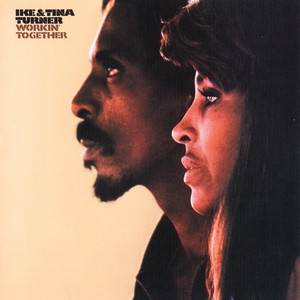
Ms. Turner sold more than 100 million records worldwide and was one of the best-selling female artists of all time and won 12 Grammy Awards.
Tributes to the life and legacy of Ms. Turner came in from around the world. “Tina Turner was raw. She was powerful. She was unstoppable. And she was unapologetically herself—speaking and singing her truth through joy and pain; triumph and tragedy. Today we join fans around the world in honoring the Queen of Rock and Roll, and a star whose light will never fade,” former U.S. President Barack Obama said on Twitter.
Angela Basset, who portrayed Ms. Turner in “What’s Love Got To Do With It,” shared her reflections on Instagram. “How do we say farewell to a woman who owned her pain and trauma and used it as a means to help change the world?” Ms. Bassett shared.
“Through her courage in telling her story, her commitment to stay the course in her life, no matter the sacrifice, and her determination to carve out a space in rock and roll for herself and for others who look like her, Tina Turner showed others who lived in fear what a beautiful future filled with love, compassion, and freedom should look like,” her post continued.
“Her final words to me – for me – were ‘You never mimicked me. Instead, you reached deep into your soul, found your inner Tina, and showed her to the world.’ I shall hold these words close to my heart for the rest of my days.
I am honored to have known Tina Turner. I am humbled to have helped show her to the world. So on today, while we mourn the loss of this iconic voice and presence, she gave us more than we could have ever asked. She gave us her whole self. And Tina Turner is a gift that will always be ‘simply the best.’ Angels sing thee to thy rest…Queen.”
Defining an era in music
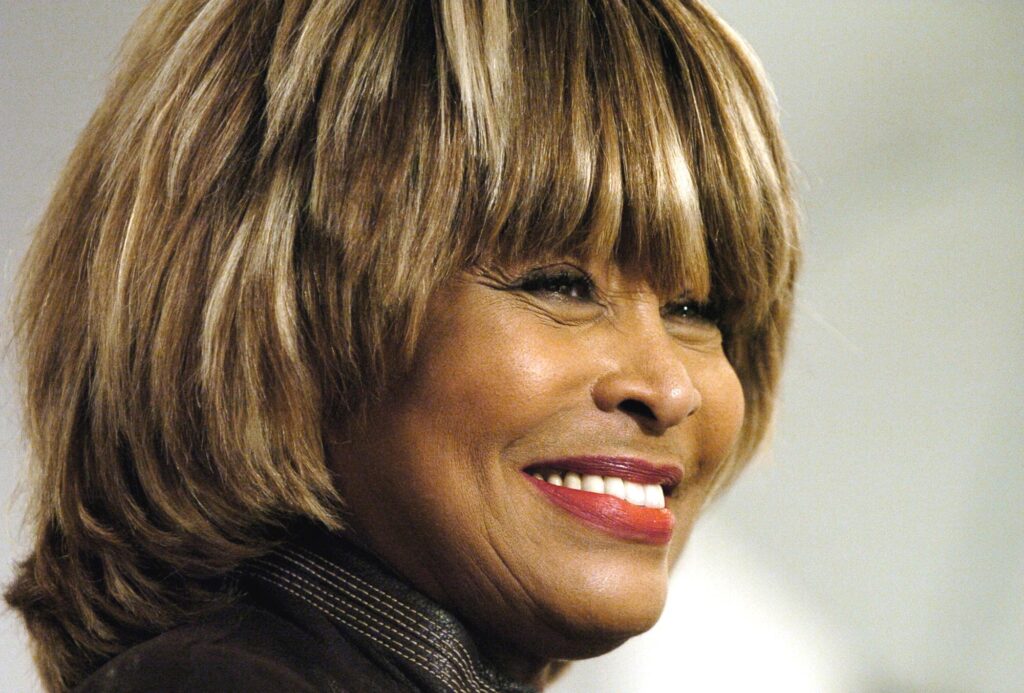
** ARCHIV ** Weltstar Tina Turner in Toronto am 24. Jan. 2005. Turner erhaelt ihre zweite Goldene Kamera. Wie die Axel Springer AG am Donnerstag, 27. Jan. 2005, in Berlin mitteilte, wird die seit Jahrzehnten im Musikgeschaeft erfolgreiche Saengerin am 9. Februar von der Fernsehzeitung “Hoer zu” mit der Goldenen Kamera in der Kategorie “Pop International” ausgezeichnet. (AP Photo/CP, Aaron Harris)
Defining an era in music
Dr. Daphne A. Brooks, professor of African American Studies and Music at Yale University and an author, told The Final Call that she views Tina Turner as an inventor of modern rock-and-roll vocals that have evolved into what is now known as modern pop vocals. Tina Turner’s major hits would grow from: “River Deep, Mountain High” and “Nutbush City Limits,” recorded in her early years with Ike, and solo albums later in her career such as 1984’s “Private Dancer,” which included her hit song “What’s Love Got to Do with It” and 1986’s “Break Every Rule.”
“She really was the bridge figure between the sound of the classic blues queens,” Dr. Brooks said. “Bessie Smith, Ma Rainey, Alberta Hunter, the early rock-and-roll pioneers, and R&B pioneers of the mid-1950s, folks like Sister Rosetta Tharpe, and Big Mama Thornton, and when I say bridge figure, she took all of that history and then translated it into the modern moment in which rock-and-roll itself was becoming further amplified and electrified,” she explained of Ms. Turner’s energy, stage presence, and talent.
“So, she cultivated and innovated a kind of vocalizing that could stand up to that heavy electric sound and hold its own,” Dr. Brooks said of Tina Turner’s unique contribution to the genre. “In terms of inventing and vocalizing, performers across the board, White men, Black men, Black women, who came after her, could tap into a Tina Turner who paved the way.”
Describing her as a musically revolutionary voice for her time, Dr. Brooks added that her unique voice and performances helped to create and define an era in American music that captivated audiences both nationally and internationally.
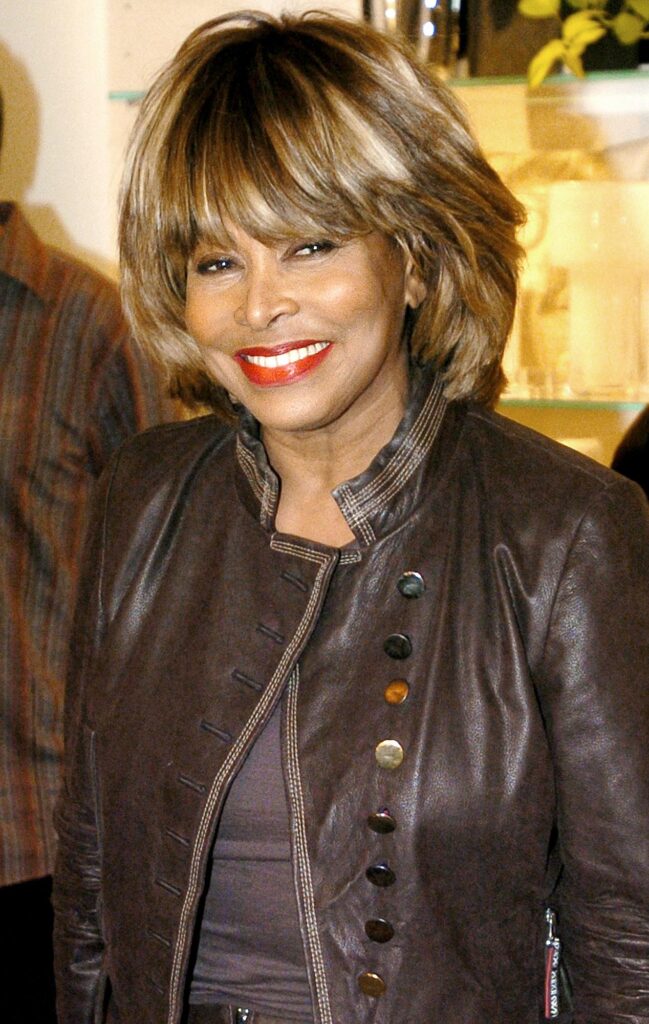
Tina Turner smiles during an appearance in Toronto Monday, January 24, 2005. A fit looking Turner brought her pipes and legs to the city on Monday, launching a week-long promotional blitz for a new compilation CD. (AP Photo/Aaron Harris)
“One of the things that is so compelling about her is that she really wanted to lean into rock-and-roll’s evolving sound, in the late ’60s and in the ’70s, as a way of laying claim to something that was revolutionary in her own spirit,” Dr. Brooks noted. “In that sense, she became a really distinctive Black woman’s voice. She added a Black woman’s perspective and embodied audacity to the sound of rock-and-roll, calling attention to the fact that African Americans were the architects of the genre itself.”
Regarding her film performances, Tina Turner’s appearances were as significant as they were few. In a 1986 broadcast with Italian interviewer Serena Dandini, Ms. Turner described herself as preferring dystopian and post-apocalyptic fiction roles over the stereotypical roles traditionally offered to Black women in the 1960s and ’70s, while referring to her 1975 film debut.
“I think the very first was ‘Tommy,’ I played the part of Acid Queen and when I took the part, I didn’t know I was playing the part of a hooker,” Ms. Turner said, recalling her character in what was both a musical and a rock opera movie. “I took the part because I got the chance to be this mad woman and when they gave me the needle (in a drug scene), I said ‘ah, I’m providing drugs!’”
Ms. Turner said in the interview that after playing the Acid Queen in “Tommy,” roles offered to her were mostly those of prostitutes and that she refused to take them.
“I didn’t want it. I didn’t just want to be on the screen just for the sake of being up there. I wanted to do something that people would remember me for, something that I would enjoy and be proud of,” she said. “I look back at Acid Queen now and sort of flinch when I see her, how horrible it was, but still, people liked it and they remembered it.”
Stating that her favorite movie role was that of Aunty Entity in the 1985 film, “Mad Max Beyond Thunderdome,” Ms. Turner said her stereotype-breaking character fit her personality as a “warrior woman” and that she admired strong female characters in science fiction movies such as Sigourney Weaver’s character in the “Alien” franchise and the Sarah Conner character in the “Terminator” films. She also said she turned down the role of Celie in Steven Spielberg’s adaptation of “The Color Purple,” and said it reminded her too much of her past.

“I don’t want to sing in a movie. I’m singing. I have my own career as a singer,” Ms. Turner stated further. “I want to do something unusual. I don’t want to be involved with something as depressing as (The Color Purple), it reflects too much back on my life with my ex-husband,” she said. “I’m talking always with the press about my life, and I have to do a movie? I’m trying to forget the past, because it’s done, it’s over, I finished that part of my life. I’m not going to do a part that reminds me of what I’ve lived already.”
Referring to Tina Turner’s part in the post-apocalyptic “Beyond Thunderdome” movie with Mel Gibson, Dr. Brooks told The Final Call that her singing of the movie’s theme song matched the tensions and politics of the 1980s and the uncertainties of the latter days of the Cold War.
“In the version where Tina Turner appears, she is leading the disaffected masses, in the wake of apocalyptic disaster, and one of my favorite songs by her comes from her performance in that film, and it’s the theme song to that film: ‘We Don’t Need Another Hero,’” Dr. Brooks added.
“It’s worth remembering that that’s a song from 1985, so deep in the Reagan, Bush one era, here we have Tina Turner, the comeback global superstar, singing what is arguably her most important social justice song, about the importance of collectivity and assembly, and being able to come together in the face of authoritarianism.”
Regarding what Tina Turner’s life represented, beyond the fame and violence she had to overcome, Dr. Brooks agreed that parallels between her being trapped in an oppressive relationship and breaking free to find her own voice, and that of the Black American experience, is worth further examination. “We don’t do ourselves any good service on lingering on the horrors that Tina Turner faced, the best place to end up is luxuriating in the riveting art that she created for us and left behind,” she said.
—William P. Muhammad, Contributing Writer
Honoring the life of Jim Brown
By Charlene Muhammad, National Correspondent
- May 30, 2023
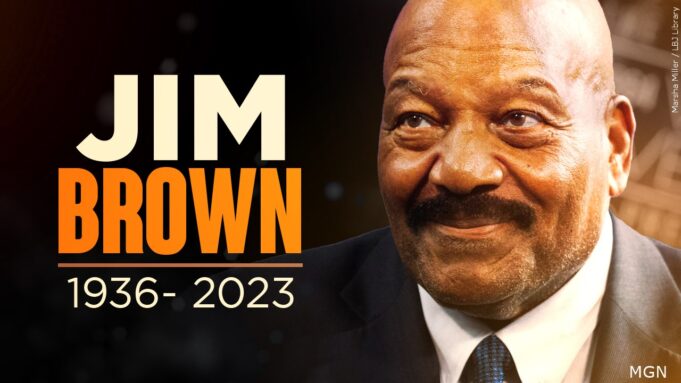
The passing of James Nathaniel Brown, known to the world as Jim Brown, has
left many saddened, but people finding comfort in his remarkable contributions
to humanity, including his athleticism, civil/human rights activism, films, and
peacekeeping discussed why he will always be remembered.
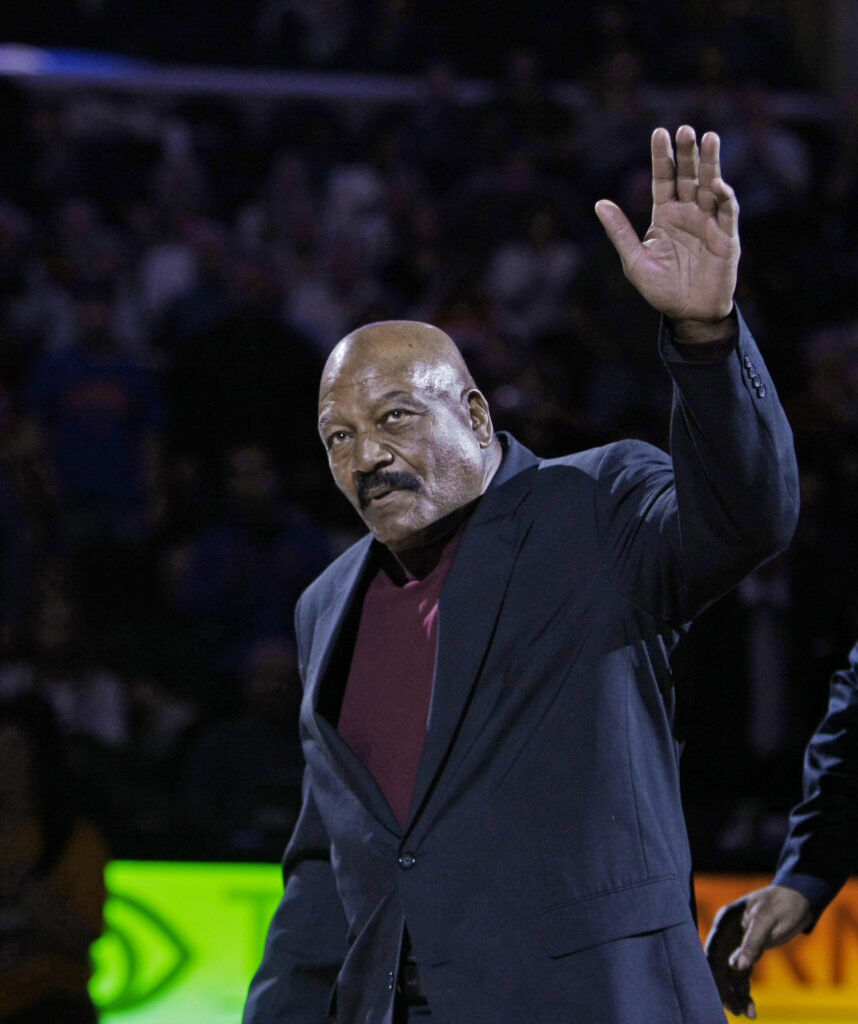
Former Cleveland Browns’ Jim Brown waves as he is introduced at
halftime during a Cleveland Cavaliers vs Toronto Raptors NBA
basketball game Tuesday, Jan. 19, 2010, in Cleveland.
(AP Photo/Tony Dejak)
With profound sadness, his wife, Monique Brown, announced his
passing on Instagram: “He passed peacefully last night at our
L.A. Home. To the world he was an activist, actor, and football star.
To our family, he was a loving and wonderful husband, father, and
grandfather. Our hearts are broken… .” Mr. Brown passed away at
the age of 87 on May 18.
In the 1960s as a member of the Nation of Islam, Muhammad Ali
shared his reasons for refusing the draft during the Vietnam War
at a meeting of the Negro Industrial and Economic Union in
Cleveland on June 4, 1967. Jim Brown was among the professional
athletes (including Bill Russell, Kareem Abdul Jabbar, Carl Stokes,
Walter Beach, Bobby Mitchell, Sid Williams, Curtis McClinton,
Willie Davis, Jim Shorter, and John Wooten) who stood with the
boxer who was outspoken on racism and issues that impacted Black
America.
“My sincerest condolences to Monique and the entire Brown family.
I am here for you in friendship & forever,” tweeted Kareem Abdul-Jabbar,
the NBA Hall of Famer. He posted that when he was 20, Mr. Brown invited
him to attend the Cleveland Summit, which was Mr. Abdul-Jabbar’s first
public support for Muhammad Ali. “Jim’s dedication to the fight for equal
rights was a lifelong effort and something that enabled me to maintain our
friendship for over 50 years. The world and I will miss him greatly,” read
his tweet.
Former Detroit Lions running back Barry Saunders posted, “You can’t
underestimate the impact #JimBrown had on the @NFL. He will be greatly
missed. Additionally, his generosity and friendship with my family is a gift
that we will always treasure. Our thoughts & prayers are with the Brown
Family & @Browns fans at this time.”
Mr. Brown, was a Cleveland Browns Hall of Fame running back and was
inducted into the Pro Football Hall of Fame in 1971 and named to the NFL’s
100th anniversary all-time team in 2019.
The NFL extended condolences to Monique Brown and their family
in a statement from Commissioner Roger Goodell. “Jim Brown was a
gifted athlete—one of the most dominant players to ever step on any
athletic field—but also a cultural figure who helped promote change.
During his nine-year NFL career, which coincided with the civil rights
movement here at home, he became a forerunner and role model for athletes
being involved in social initiatives outside the sport. He inspired fellow
athletes to make a difference, especially in the communities in which they
lived,” said Mr. Goodell.
“It’s impossible to describe the profound love and gratitude we feel for
having the opportunity to be a small piece of Jim’s incredible life and l
egacy. We mourn his passing, but celebrate the indelible light he brought
to the world,” The Cleveland Browns said in a statement on Twitter.
“Jim Brown Forever,” tweeted the Cleveland Browns, who called him
a legend, leader, activist and visionary.
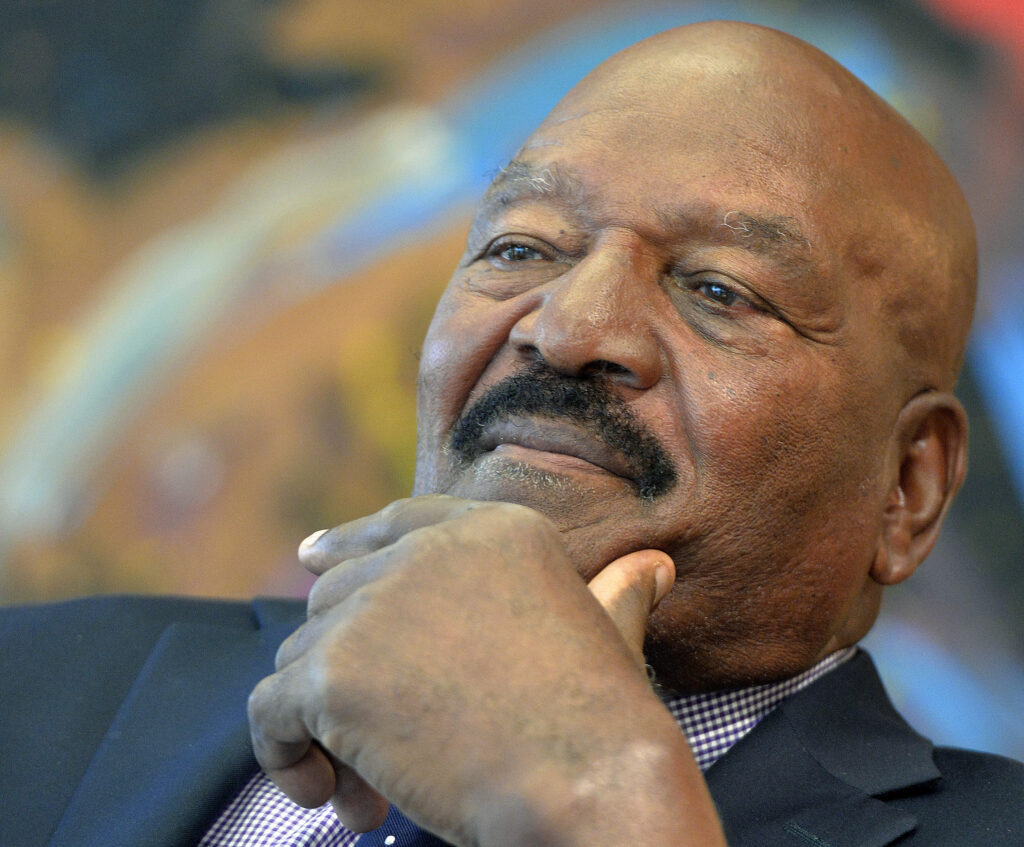
In this Sept. 27, 2014, file photo, Hall of Fame football player Jim
Brown meets with other participants of the Muhammad Ali
Humanitarian Award at the Muhammad Ali Center in Louisville, Ky.
A social activist most of his adult life, Brown has been encouraged to
see athletes make powerful societal statements and voice their opinions
in the wake of recent protests around the country.
(AP Photo/Timothy D. Easley, File)
“We lost a hero today. Rest in Paradise to the legend Jim Brown. I hope
every Black athlete takes the time to educate themselves about this
incredible man and what he did to change all of our lives. We all stand
on your shoulders Jim Brown,” said Lebron James of the L.A. Lakers
on Instagram on May 19.
“If you grew up in Northeast Ohio and were Black, Jim Brown was
a God. As a kid who loved football, I really just thought of him as the
greatest Cleveland Brown to ever play. Then I started my own journey
as a professional athlete and realized what he did socially was his true
greatness. When I choose to speak out, I always think about Jim Brown.
I can only speak because Jim broke down those walls for me,” the NBA
all-time leading scorer continued.
“I am so grateful that I was able to call you my friend. I hope I can
continue to honor your legacy with my words and actions. My prayers
to your family. I know they are all incredibly proud of everything you
did for our community! #LegendsNeverDie,” added Mr. James’ post.
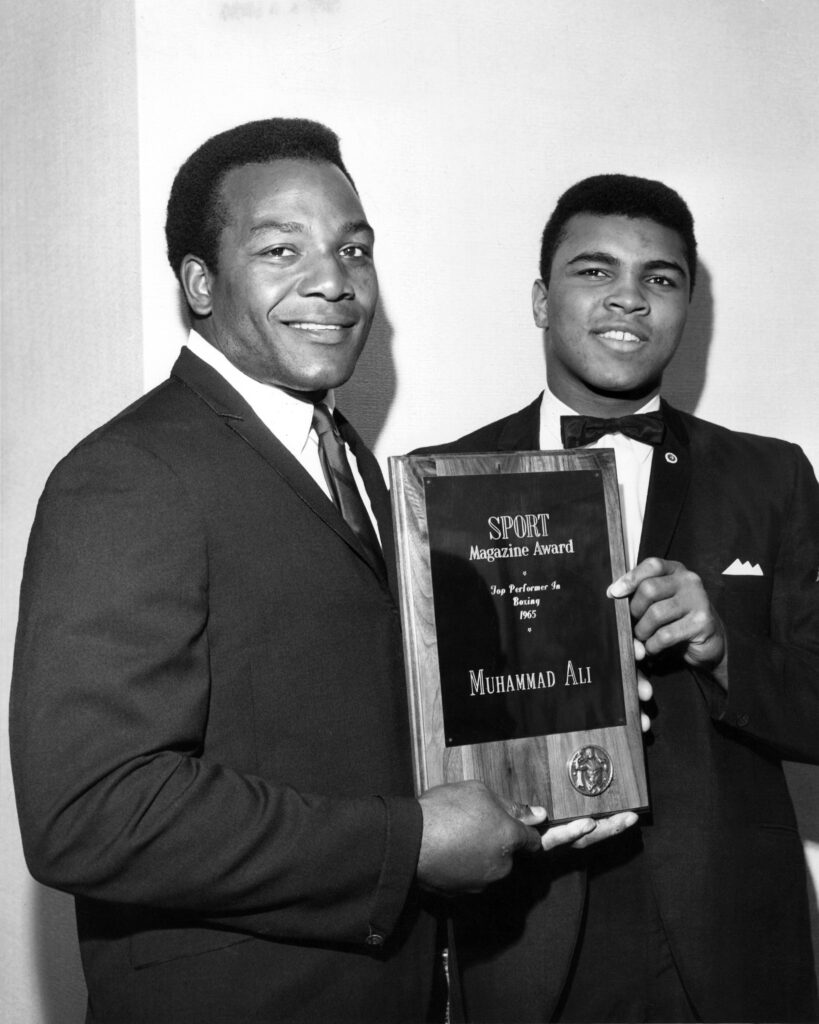
Jim Brown with Muhammad Ali (Cassius Clay) at Sport Magazine
Top Performance Award on Jan. 19, 1966. (AP Photo)
Mr. Brown was a man who made his own decisions even if others did
not understand or agree with him and like all human beings, he was imperfect.
But his conflict resolution efforts, which he was fully committed to, saved
and impacted many lives.
Student Minister Abdul Malik Sayyid Muhammad, Western Region
Representative of the Honorable Minister Louis Farrakhan and the
Nation of Islam, grew to know and love Mr. Brown through his
Amer-I-Can Life Skills Management Program, now being taught in
schools, jails, and prisons across the country.
“I learned a lot from Jim, in terms of how Jim related to the brothers and
sisters in the street, being that he’s the great, Jim Brown, legendary football
player and actor. Similar to Harry (Belafonte), he didn’t have that kind of chip
on his shoulder, thinking he was ever better than his people,” stated Student
Min. Muhammad.
According to Student Min. Muhammad, Mr. Brown’s interactions with gang
leaders and members left a lasting impact. By providing support and encouragement,
he empowered them to transition from a negative to a positive lifestyle. This
approach was incredibly influential and meaningful.
“That won me over! Because he had a powerful, powerful Amer-I-can program,
which actually became the catalyst and I would say the template for gang intervention
in Los Angeles, that started maybe a few years after Amer-I-Can,” explained
Student Min. Muhammad.
“He was like the go-to cat for all these brothers and sisters in the streets. They
trusted Jim and they could go to Jim for advice and it was just beautiful to see
that all these brothers and sisters in the streets—hardened, ex-criminals—
trusted Jim Brown because it’s hard to win the trust of the streets,” he stated.
Student Min. Muhammad expressed admiration for Mr. Brown’s exceptional
achievements, emphasizing that his unparalleled athletic accomplishments
during the turbulent 1960s, a time marked by significant challenges for Black
people, solidify his status as the greatest. Additionally, he acknowledged Mr.
Brown’s courageous stance as one of the first Black athletes to jeopardize his
career for the advancement of Black people.

Reportedly, in 1966, Mr. Brown announced his retirement to pursue
his acting career and other interests. After the 1965 season ended, Mr.
Brown was filming “The Dirty Dozen” in London, when Cleveland Brown’s
owner Art Modell issued an ultimatum by threatening to fine him if the
running back was late or failed to show up to training camp. He was only
29 when he stepped away from the NFL.
“I honestly like you and will be willing to help you in any way I can, but I
feel you must realize that both of us are men and that my manhood is just
as important to me as yours is to you,” wrote Mr. Brown, in a letter attributed
to him on andscape.com website. He held a press conference to announce his
retirement from football, because of the future he desired for himself, his
family and his race, according to the letter. Andscape, formerly The Undefeated,
is a sports and pop culture website owned and operated by ESPN.
“Of course, I don’t think White America is going to remember him for that,
but I truly believe that Black America and people all over the world will
remember his stance on tyranny and injustice,” said Student Min. Muhammad.
“He was one of the first athletes to come from his lofty position into hell
and work with the downtrodden. It just reminds me of what Jesus said to
his disciples, when he talked about those who were in prison and you
administered not unto them. That’s what Jim Brown did, and so his legacy
among just the people in the streets became quite outstanding. He’s a hero
to them. He was a leader to them. He was like a big-time advisor to the streets,
so the streets will remember Jim as a revolutionary hero,” he added.
“I met Jim through Minister (Louis) Farrakhan, in 1989, through the
‘Stop the Killing’ tour,” stated Aqeela Sherrills, a co-founder of Amer-I-can.
“Minister Farrakhan came to town and galvanized thousands of the folks from
the city to come together around all of the killings that was happening in the city,”
said Mr. Sherrills, who said he grew up in the Jordan Downs Housing Projects,
and was a member of Grape Street Crips.
As an activist/organizer trying to stop the killing, he and colleagues took about
30 young Black men to hear Min. Farrakhan speak, said Mr. Sherrills.
“We were all so moved. Fifteen hundred Crips and Bloods showed up that
day at the Sports Arena for that conversation and then Jim opened up his house
as a neutral ground for us to meet and have conversation,” stated Mr. Sherrills.
He told The Final Call that because of the meeting hosted by the Minister and
Mr. Brown, he had an opportunity to connect with them and represent his
neighborhood. Mr. Brown gave him his phone number and invited him to
visit his home any time he needed a break from the neighborhood, shared
Mr. Sherrills.
“Jim was the catalyst, one of the key financiers behind the movement early
on,” Mr. Sherrills continued. “Minister Farrakhan put out the call and Jim
showed up and became more like a mentor and a father to many of us in L.A.,
and then across the country,” he stated.
For Mr. Sherrills the thing that Mr. Brown will be most remembered for in
his life is his mentorship and guidance. “Jim was probably one of the most
brilliant cats that I’ve ever met. I’ve never been in a room with J. B. where
he hadn’t briefed us before we got there so that we could all be on the same
page in terms of the conversation, and then debriefed after every meeting,”
said Mr. Sherrills.
He described Mr. Brown as being far ahead of his time and said that in
the ’60s when the talk was about civil rights, Mr. Brown was focused
on human rights.
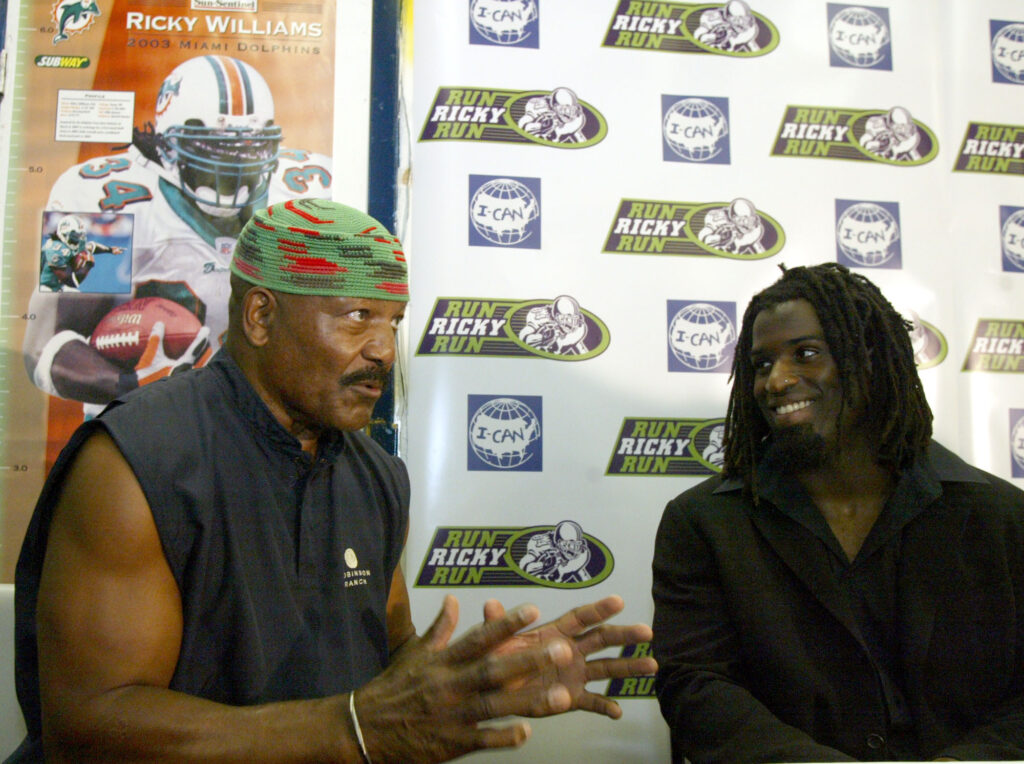
Hall of Fame running back Jim Brown, left, and Miami Dolphins
running back Ricky Williams chat before a news conference Tuesday,
Sept. 23, 2003, in Miami. Brown and Williams announced that Williams’
foundation, Run Ricky Run, is now donating some of its proceeds to the
Amer-I-Can program, founded by Brown to help quell gang violence and
educate troubled youth. (AP Photo/Wilfredo Lee)
“Jim was there for me through all of my formative years and transformations
and I love him forever for the contribution that he’s made to my life, but also
to thousands. I traveled with Jim as his right hand for almost a decade to cities
all across the country and it was just an honor always to be in service to something
that was so much bigger than us and that’s the peace movement. And we see
where things are today as a result of his work and the Minister’s work.”
Mr. Sherrills highlighted an example of the evolving approach to addressing
street peace. He mentioned that under the Biden Administration, community-based
solutions are now acknowledged as complementary strategies alongside the police.
These strategies are seen as vital and worthy of investment to strengthen the
country’s safety infrastructure, said Mr. Sherrills.
“There’s about three or four of us, national thought leaders in the country who
were all trained by Jim, that are sitting at the table,” stated Mr. Sherrills, who
added that in 2021, he ran the White House Community Violence Intervention
Collaborative, a 16-city initiative to do a proof of concept, building the capacity
of community violence intervention as a complimentary strategy to policing in cities.
From there came the 2022 bi-partisan Safer Communities Act, which he
emphasized put $250 million into community violence intervention. “When
we started this work in the late ’80s, early ’90s, Jim financed this work himself,
with support from a few people! And now, we’ve got the federal government
… at the foundation of that is J.B.,” Mr. Sherrills added.
Marcus Bell met Mr. Brown in 1997, through Darren “Bo” Taylor, deceased
former Crip and gang mediator of Unity One gang intervention effort. Twenty-five
years later, Mr. Bell teaches the Ameri-I-Can program in Chicago with Melvyn
Hayward, co-founder with Ansar El Muhammad and Clinton Noble of Venice
2000 gang intervention and prevention.
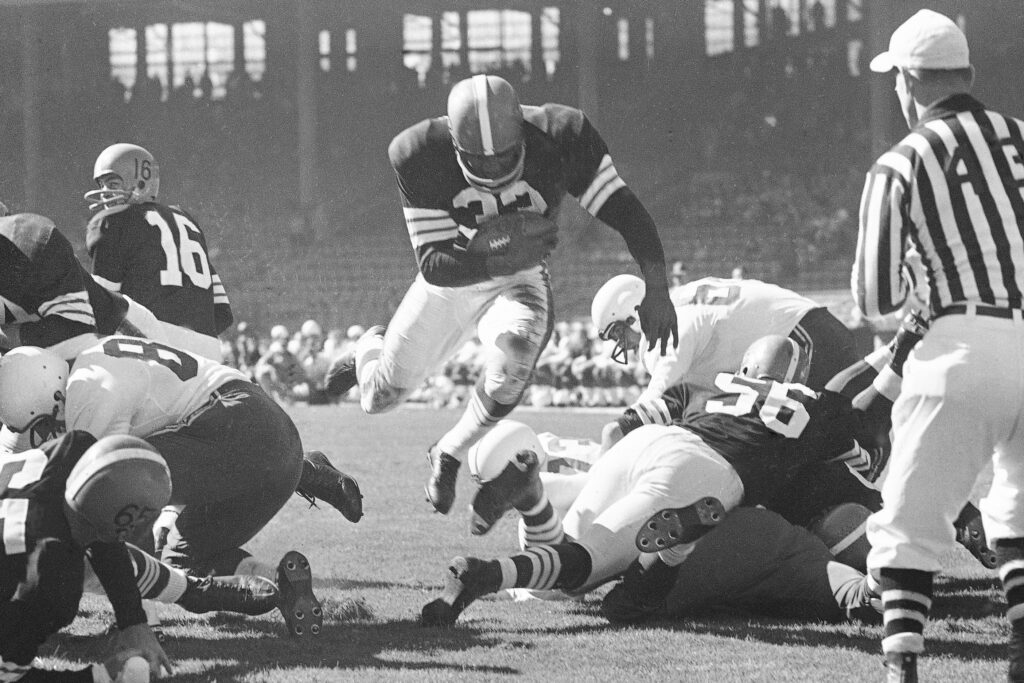
In this Oct. 12, 1958, file photo, Cleveland Browns fullback Jim Brown runs
against the Chicago Cardinals for a touchdown in the first half of a football
game in Cleveland. Brown scored three touchdowns in Cleveland’s 35-28 win.
Brown led the NFL in rushing eight times and was league MVP three times;
finished with more than 12,000 yards rushing and 106 rushing touchdowns;
and averaged 5.2 yards per carry. And he did all this in only nine seasons before
retiring at age 30 to become an actor. (AP Photo/File)
“He’s a humanitarian. He stopped playing football and lacrosse and Jim Brown
just got into the community, which was on his heart,” said Mr. Bell. “It’s been a
big impact because if it wasn’t for Jim Brown, speaking for myself, a lot of these
communities would have had even more losses than what we had today, because
we took that (Amer-I-Can) curriculum to them. … I can honestly say if it wasn’t
for that curriculum, I’d probably have a life sentence or be dead,” Mr. Bell told
The Final Call.
News of his mentor’s passing literally took him off of his feet, said Mr. Hayward,
who is also chief program officer for Chicago CRED (Create Real Economic Destiny),
an anti-gun violence organization.
“Jim means so much to me and us as a people, and knowing that Jim has been
and was on the front line for over 50 years, representing Black people and our
excellence and what it means to be Black in America and how we give back to
one another and be consistent about our love in our education and our willingness
to atone and reconcile with one another, it really touched my life,” stated Mr.
Hayward.
Ansar El Muhammad reflected on Mr. Brown’s selflessness, care and humor.
Mr. Brown funded their organization at $2,000 a month, according to Ansar
El Muhammad, but one day he took them to meet a friend in Leimert Park.
The late great NBA great Bill Russell exited a shop, and Mr. Brown told them,
“Hey, Bill! These are the guys that you’ve been supporting for a whole year,’”
said Ansar El Muhammad, as he laughed at the fond memory.
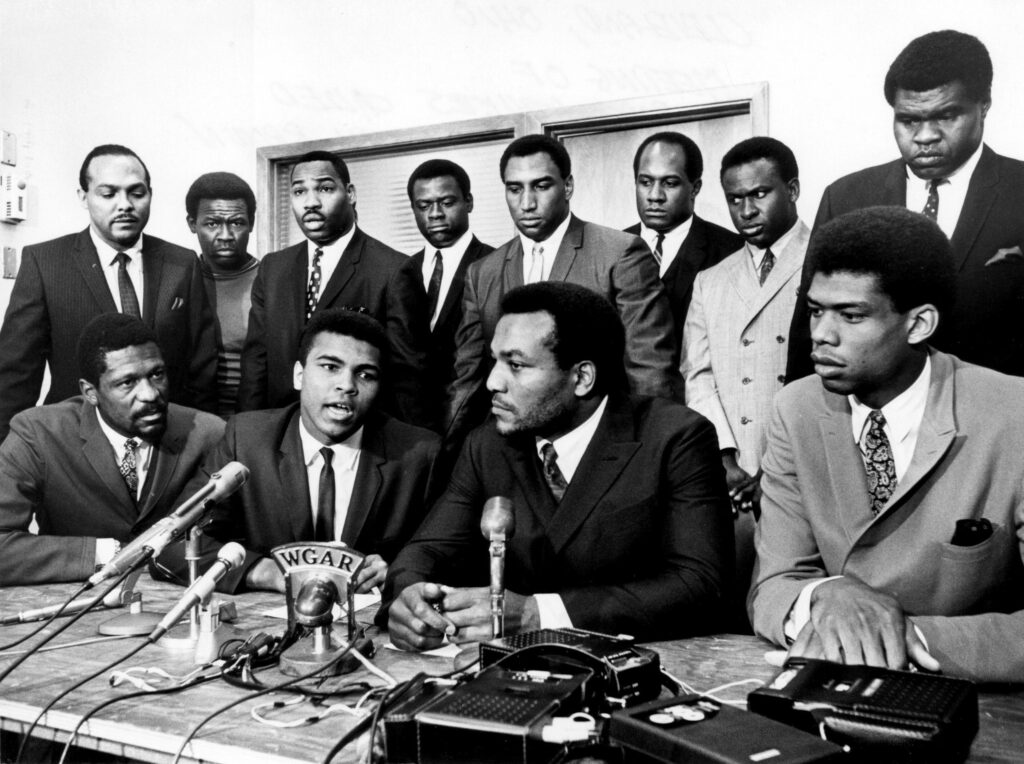
Former Cleveland Browns Hall of Fame running back Jim Brown
presides over a meeting of top African-American athletes who supported
boxer Muhammad Ali’s refusal to fight in Vietnam on June 4, 1967.
Pictured: (front row) Bill Russell, Muhammad Ali, Jim Brown, Lew
Alcindor; (back row) Carl Stokes, Walter Beach, Bobby Mitchell,
Sid Williams, Curtis McClinton, Willie Davis, Jim Shorter, and John
Wooten. (AP Photo/Tony Tomsic)
“I will remember Jim as more than an NFL player,” he said. The larger than life
figure would state that though it was great to be in the NFL and Hall of Fame as
an individual, the work being done through Amer-I-Can and organizing former
gang members and ex-offenders and working with them is more fulfilling than
anything he ever did in the NFL or Hollywood because he saw the transformation
in the lives of human beings who were disregarded as individuals and who otherwise
may never make it back into mainstream society,” added Ansar El Muhammad.
“He would say, ‘Hey! Gentlemen! It’s never too late to obtain a full, meaningful
life!’ That stuck with me,” he added.
According to The Associated Press, Mr. Brown is survived by his wife Monique
and son, Aris; daughter, Morgan, son, Jim Jr.; daughter, Kimberly; son, Kevin;
daughter, Shellee; and daughter, Kim. He was preceded in death by his daughter,
Karen Ward.
